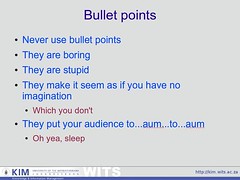If KM is a lean supply chain of knowledge, how can you measure the waste in order to eliminate it?
 |
| Shredded waste, image from wikimedia commons |
The concept of Knowledge Management as a supply chain is one I have been incubating for a few years (see
here,
here,
here,
here for example). I presented the idea at KM World last week, and got some very good feedback.
I presented the idea of KM as a supply chain, providing knowledge to the knowledge worker, and used the concept of the lean supply chain to suggest that we could
eliminate "the 7 wastes", and make the transfer of knowledge more efficient.
Then one person asked "how can we measure that waste"?
I didn't know the answer, but said I would think about it and blog an answer.
Here it is.
- Waste #1. Over-production—producing more knowledge than we need.
We might measure this by measuring how much of what is published is actually useful. We could for example look at the read-rates of content (how much content never gets read), or the duplication of content. We could look at the push/pull ratio in communities of practice, balancing the number of question-led discussions against the number of publication-based discussions (see
this analysis of linked-in discussions, for example).
Here we measure the clock-speed of knowledge, such as the time it takes for a community question to be answered, the time it takes to find relevant synthesised knowledge, or the time it takes for lessons to be a) collected and b) embedded into guidance.
- Waste # 3. Unnecessary transport of materials.
In our knowledge management world, this really refers to hand-off, and we might measure the number of links or steps between knowledge supplier and user. Communities of practice, for example, where "ask the audience"-type questions can be asked, and answered directly by the knowledge holder, will minimise the number of handoffs. With a large community of practice, everyone is at One Degree of Separation.
- Waste # 4. Non-value added processing—doing more work than is necessary.
We might measure this by looking at the degree of processing the end user has to do to get an answer to their question, and how much synthesising is done by the user, which could be done further up the supply chain. For example, does a user have to read and understand all lessons in a database on a particular topic, or have these already been synthesised into guidance?
- Waste # 5. Unnecessary motion.
We measure this by counting the number of places the knowledge user needs to go to in order to find relevant knowledge. Do they have to visit every project file to find lessons, or are the lessons collected in one place? Is there one community of practice to go to, or many? Linked-in, for example, has (or had at one time) 422 discussion groups covering the topic of Knowledge Management rather than only one. That is a waste of 421 groups (99.8% waste).
- Waste # 6. Excess inventory
Like waste 1, we look at the unnecessary, duplicate or unread knowledge in the knowledge bases and lessons learned systems.
Here we measure now much knowledge is out of date, and how much is poor quality. Some organisations, for example, measure the quality of lessons with a lessons database, and often find that much of the content is of very poor quality.






















